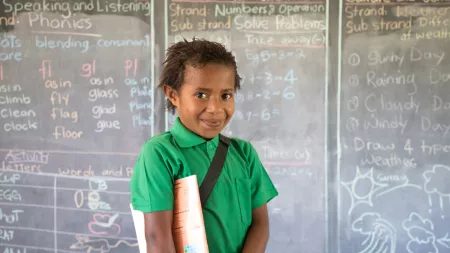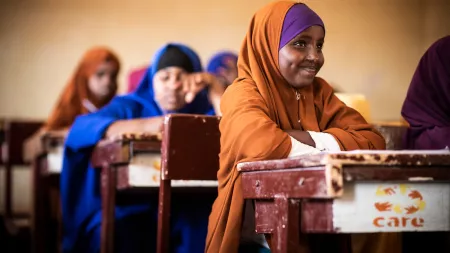Equal access to education
Education systems around the world have been disrupted by COVID-19, leaving an estimated 1.2 billion children out of school. Marginalized adolescent girls are heavily affected, facing the combination of school closures, higher workloads at home, extreme poverty and the threat of gender-based violence.
Increasing equal access to education helps to combat child marriage, early pregnancy and child labor and enhances girls’ social, political and economic agency and ability to seize their rights and unlock their own potential.
What is CARE International doing to improve access to education?
CARE International believes that every child has the right to a quality education, and every government has a responsibility to educate all children.
Our interventions bring together communities, schools, governments, and other partners to create sustainable, innovative solutions to ensure that marginalized children, especially girls, can stay in school, succeed academically, complete a relevant education, and obtain dignified work.
CARE International aims to increase equal access to inclusive education and skills development, especially for girls. During the COVID-19 pandemic, we worked with governments, teachers, girls’ clubs, and communities to provide remote learning along with diverse forms of support tailored to adolescent girls’ needs.
Evidence shows that interventions on social norms and girls’ leadership skills development have contributed to an increase in communities’ resilience during the pandemic, reducing barriers to girls’ participation in remote education and building conditions for adolescent girls to continue to learn.
Children are naturally hungry to learn, but face daunting barriers to attending school, especially girls. CARE International works to address underlying barriers to education, in ways that increase learning opportunities.
What barriers keep girls out of school?
CARE International identifies and addresses the unique barriers that keep girls out of school. We also work with boys and men to help identify and address these barriers.
These barriers include:
-
Chores: Through our work and research in Cambodia, Tanzania, and Mali, household and community discussions, we identified that girls can have six times higher domestic workloads than boys their same age. As a result, girls often miss critical learning hours. Furthermore, they frequently spend daylight hours doing household chores or labor for wages, preventing them from studying while it is light outside. For many, sunlight is the only source of light available for studying and work.
-
Early marriage: Girls are entering into early marriages at an alarming rate. They are often married early to alleviate their family’s financial burden, far before they are ready for marriage physically and mentally.
-
Lower social status: Because girls generally have a lower social status than their brothers, their education is valued less. When resources are scarce, and there are both real and opportunity costs associated with going to school, many families opt to educate their boys over their girls. Additionally, classroom teachers, materials, and methodologies are often skewed to favor boys.
-
School safety: School safety remains a critical barrier for girls to attend school. If the journey to school and the school environment are not safe, parents will not enroll their daughters, and girls will not attend.
-
Sanitation: Having access to basic clean water and a decent toilet saves children's lives, gives women an advantage in earning money and ensures a good food supply. Improved sanitation can keep a girl in school by making facilities available to her when she reaches puberty.
-
Hunger: Malnutrition affects every stage of life and has severe consequences that can impact generations. Children born to malnourished mothers are at increased risk for disease and death. Chronically malnourished children face lifelong consequences in reduced mental capacity, lower retention in school, and reduced lifetime earnings.
-
Conflict: Education can be a life-saving resource that re-establishes a vulnerable child’s sense of normalcy and builds self-esteem and hope for the future. Many experts consider education an essential humanitarian response to complex emergencies, closely following food, water and shelter.


